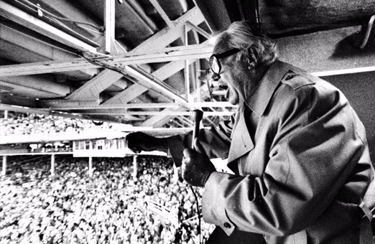Strives for Innovation (NT) / Cooperation (NF)
One of the differences between “NT” Rationals and “NF” Idealists is that Rationals prefer to work with things while Idealists prefer to work with people.
Rationals place a high value on efficiency and often become innovators in an effort to improve products and processes. They let their imaginations consider how things could be done differently to produce better results.
Idealists tend to discard more effective methods to accomplish something if they believe they will hurt anyone’s feelings. They want to unify people, to work together in cooperation toward the same goal.
But in 1976, the owner of the Chicago White Sox secretly placed a microphone in Harry’s booth and turned it on when the organist started playing the song. It was a hit, and Harry became famous for years of uniting fans in rooting for the home team.
His trademark introduction was: “All right! Lemme hear ya! Ah-One! Ah-Two! Ah-Three!” Near the end of the song he held the microphone out to the crowd to end with a climactic group finish.


Mark Twain’s innovations centered around books. For one thing, he invented a new way of writing dialogue that used incomplete words, slang, and broken grammar to capture the way people really spoke. It was a brand new concept, vulnerable to scorn by rule-following publishers, editors, and fellow writers. Instead, it became the “Great American Novel” known as The Adventures of Huckleberry Finn (1884).
A Connecticut Yankee in King Arthur’s Court (1889) was another innovation to the written word. Until then, history was written as if it was in the past. When Twain sent a man from the present back to the time of King Arthur’s Court, he wrote it from the modern man’s point of view, bringing history “alive” for the first time.
But the book that brought Twain the most profit in his lifetime was a self-pasting scrapbook he invented in 1873. To avoid the process of having to make glue and brush it on papers without making a mess, the blank pages of his book were covered in a glue substance that was activated when wet.
Harry Caray’s enthusiasm for baseball was contagious. But nothing endeared him to baseball fans as much as when he sang “Take Me Out to the Ballgame” during the seventh-inning stretch. A true ENFP Champion, he participated without organizing, instructing, or leading others for most of his career. He simply sang from his heart where only a select few could hear him.
Mark Twain (ENTP) / Harry Caray (ENFP)
Thomas Jefferson (INTP) / Pope John Paul II (INFP)
Thomas Jefferson was more than a Founding Father of America, he was also an innovator. Interested in improving existing devices, he invented the Jefferson Plow by correcting a flaw in the Dutch design, making lifting and turning sod much more efficient. After enjoying the pasta of France, Jefferson came back to America and designed a machine to make pasta quickly and easily. While serving as America’s first Secretary of State, foreign policy and national security prompted him to design a wheel cipher to scramble and unscramble important messages.
The Great Clock at Monticello is one of Jefferson’s most impressive innovations. Powered by cannonballs as weights to drive the clock’s ticking and occasional striking of a gong on the roof, Jefferson designed it to be read inside and outside of the house. While the outside clock face has only an hour hand, the inside view displays the hour, minute, and second. Labels next to the vertical path of the cannonballs indicate the day of the week.
While Thomas Jefferson saw the potential in things, Pope John Paul II believed in the potential of people. His goal for Jews, Muslims, and Christians to live together in peace relied on cooperation on a massive scale. Seeking spiritual unity, the Pope emphasized the beliefs that religions have in common and summoned world leaders of all religions to pray for world peace. He preached the importance of human dignity, a value he believed could bring humanity together in peaceful coexistence and cooperation.
The Pope also collaborated with President Ronald Reagan in an effort to end Soviet oppression in Eastern Europe. The two leaders met and talked often about methods of putting political and economic pressure on the Soviet Union. Today, a bronze sculpture of John Paul and Ronald Reagan walking together stands at the birthplace of Polish Solidarity to honor the two men credited with the fall of communism.

